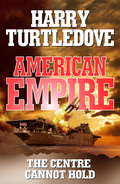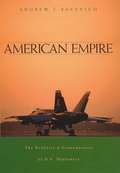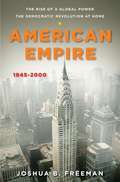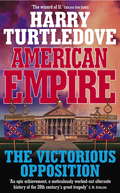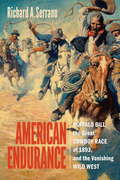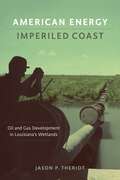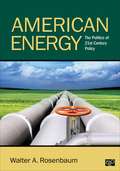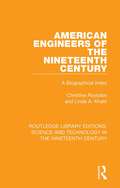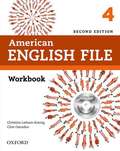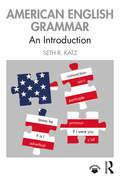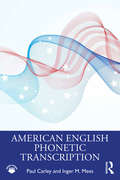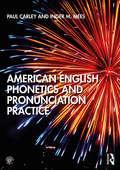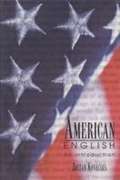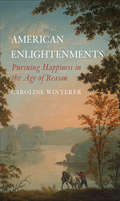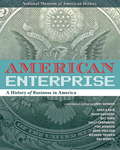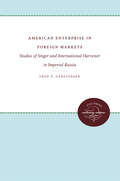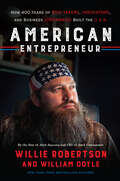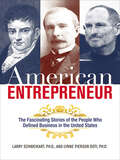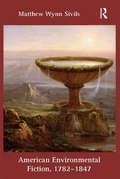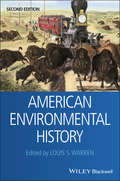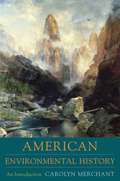- Table View
- List View
American Empire: The Centre Cannot Hold Ebook
by Harry TurtledoveTurtledove's alternate history of America in the last 150 years continues . . . The second book in the American Empire sequence takes the violent American civil war (which has become a world war) to 1924: a time of rebuilding. Life is slowly returning to normal in the devastated cities of Europe and Canada. In the United States, the Socialist Party battles Calvin Coolidge to hold on to power. And it seems as if the Socialists can do no wrong as the stock market soars and America enjoys a prosperity unknown for half a century. But as old names like Custer and Roosevelt fade into history a new generation faces new uncertainties,.In a world of occupiers and the occupied, of simmering hatreds, shattered lives and pent-up violence, the centre can no longer hold. And for a powerful nation, the ultimate shock will come when a fleet of foreign aircraft rains death and destruction on one of the great cities of the United States.
American Empire: The Realities and Consequences of U. S. Diplomacy
by Andrew J. BacevichArguing that since the end of the Cold War, American foreign policy makers have pursued a well-defined grand strategy aimed at preserving and expanding an American Imperium, Bacevich (international relations, Boston U. ) contends that the strategy is continuous with policies pursued during the Cold War. The stated goal of containing communism was only incidental to a larger goal of worldwide commercial integration, a process that is seen as inexorable and beneficent, but paradoxically requires the use of overwhelming military power in response to challenges. The author calls for recognition of the empire, so that it can be better governed. Annotation c. Book News, Inc. , Portland, OR (booknews. com)
American Empire: The Rise of a Global Power, the Democratic Revolution at Home 1945-2000
by Joshua B. FreemanIn this landmark work, acclaimed historian Freeman has created an epic portrait of the movements and developments that propelled America to world dominance both galvanized by change and driven by conflict.
American Empire: The Victorious Opposition Ebook
by Harry TurtledoveTurtledove's alternate history of America in the last 150 years continues . . . The final book in the American Empire sequence takes the violent American civil war (which has become a world war) to the 1930s. Seventy years have passed since the first War Between the States. The North American continent is locked in a battle of politics, economies and moralities. In a world that has already felt the soul-shattering blow of the Great War, North America in 1934 is the powder keg that could ignite another global conflict.The Victorious Opposition is a drama of leaders and followers, spies and traitors, lovers and soldiers. From California to Canada, from combat on the high seas to the secret meetings where former slaves plot a desperate strategy for survival, Harry Turtledove has created a human portrait of a world in upheaval.
American Endurance: Buffalo Bill, the Great Cowboy Race of 1893, and the Vanishing Wild West
by Richard A. SerranoPulitzer Prize-winning journalist and author Richard A. Serrano's new book American Endurance: Buffalo Bill, the Great Cowboy Race of 1893, and the Vanishing Wild West is history, mystery, and Western all rolled into one. In June 1893, nine cowboys raced across a thousand miles of American prairie to the Chicago World's Fair. For two weeks they thundered past angry sheriffs, governors, and Humane Society inspectors intent on halting their race. Waiting for them at the finish line was Buffalo Bill Cody, who had set up his Wild West Show right next to the World's Fair that had refused to allow his exhibition at the fair.The Great Cowboy Race occurred at a pivotal moment in our nation's history: many believed the frontier was settled and the West was no more. The Chicago World's Fair represented the triumph of modernity and the end of the cowboy age. Except no one told the cowboys. Racing toward Buffalo Bill Cody and the gold-plated Colt revolver he promised to the first to reach his arena, nine men went on a Wild West stampede from tiny Chadron, Nebraska, to bustling Chicago. But at the first thud of hooves pounding on Chicago's brick pavement, the race devolved into chaos. Some of the cowboys shipped their horses part of the way by rail, or hired private buggies. One had the unfair advantage of having helped plan the route map in the first place. It took three days, numerous allegations, and a good old Western showdown to sort out who was first to Chicago, and who won the Great Cowboy Race.
American Energy, Imperiled Coast: Oil and Gas Development in Louisiana's Wetlands (The Natural World of the Gulf South #5)
by Jason P. TheriotIn the post--World War II era, Louisiana's coastal wetlands underwent an industrial transformation that placed the region at the center of America's energy-producing corridor. By the twenty-first century the Louisiana Gulf Coast supplied nearly one-third of America's oil and gas, accounted for half of the country's refining capacity, and contributed billions of dollars to the U.S. economy. Today, thousands of miles of pipelines and related infrastructure link the state's coast to oil and gas consumers nationwide. During the course of this historic development, however, the dredging of pipeline canals accelerated coastal erosion. Currently, 80 percent of the United States' wetland loss occurs on Louisiana's coast despite the fact that the state is home to only 40 percent of the nation's wetland acreage, making evident the enormous unin-tended environmental cost associated with producing energy from the Gulf Coast.In American Energy, Imperiled Coast Jason P. Theriot explores the tension between oil and gas development and the land-loss crisis in Louisiana. His book offers an engaging analysis of both the impressive, albeit ecologically destructive, engineering feats that characterized industrial growth in the region and the mounting environmental problems that threaten south Louisiana's communities, culture, and "working" coast. As a historian and coastal Louisiana native, Theriot explains how pipeline technology enabled the expansion of oil and gas delivery -- examining previously unseen photographs and company records -- and traces the industry's far-reaching environmental footprint in the wetlands. Through detailed research presented in a lively and accessible narrative, Theriot pieces together decades of political, economic, social, and cultural undertakings that clashed in the 1980s and 1990s, when local citizens, scientists, politicians, environmental groups, and oil and gas interests began fighting over the causes and consequences of coastal land loss. The mission to restore coastal Louisiana ultimately collided with the perceived economic necessity of expanding offshore oil and gas development at the turn of the twenty-first century. Theriot's book bridges the gap between these competing objectives.From the discovery of oil and gas below the marshes around coastal salt domes in the 1920s and 1930s to the emergence of environmental sciences and policy reforms in the 1970s to the vast repercussions of the BP/Deepwater Horizon oil spill in 2010, American Energy, Imperiled Coast ultimately reveals that the natural and man-made forces responsible for rapid environmental change in Louisiana's wetlands over the past century can only be harnessed through collaboration between public and private entities.
American Energy: The Politics of 21st Century Policy
by Walter A. RosenbaumThere are rapid, and sometimes radical, changes now transforming energy production and consumption in the United States. Utilizing contemporary examples throughout his narrative, Walter A. Rosenbaum captures this transformation in American Energy: The Politics of 21st Century Policy while analyzing how important actors, institutions, and issues impact American energy policymaking. With clear explanations of relevant energy technologies—from controversial fracking to mountain top mining to nuclear waste storage—the book first looks at the policy options available in governing the energy economy and then discusses specific resources (petroleum and natural gas, coal, nuclear power, electricity, renewable energy, conservation) and the global energy challenges associated with climate change. This is a perfect supplement for any environmental politics course.
American Energy: The Politics of 21st Century Policy
by Walter A. RosenbaumThere are rapid, and sometimes radical, changes now transforming energy production and consumption in the United States. Utilizing contemporary examples throughout his narrative, Walter A. Rosenbaum captures this transformation in American Energy: The Politics of 21st Century Policy while analyzing how important actors, institutions, and issues impact American energy policymaking. With clear explanations of relevant energy technologies—from controversial fracking to mountain top mining to nuclear waste storage—the book first looks at the policy options available in governing the energy economy and then discusses specific resources (petroleum and natural gas, coal, nuclear power, electricity, renewable energy, conservation) and the global energy challenges associated with climate change. This is a perfect supplement for any environmental politics course.
American Engineers of the Nineteenth Century: A Biographical Index (Routledge Library Editions: Science and Technology in the Nineteenth Century #8)
by Christine Roysdon Linda A. KhatriFirst published in 1978. This biography aims solve the problem of the lack of access to information regarding American engineers and technologists of the nineteenth-century, whilst also providing opportunities for scholars to study and assess the work of hitherto little known, potentially important figures. This title will be of interest to scholars and students of science and history.
American English File With Online Practice: Level 4
by Christina Latham-Koenig Clive Oxenden Paul SeligsonFour-skills American English course with a communicative methodology, engaging texts, and a strong pronunciation syllabus - designed to get students speaking. With texts and topics that make learners want to speak, American English File is the course that gets students talking. It gives you full skills coverage with a clear focus on pronunciation, plus wide-ranging support and resources too. Resources include Test Generator CD-ROMs, DVDs, Multi-ROMs, and websites. The highly popular teacher's site has extra lesson ideas and resources for you to download.
American English File Workbook
by Christina Latham-Koenig Clive Oxenden Jane HudsonFour-skills American English course with a communicative methodology, engaging texts, and a strong pronunciation syllabus - designed to get students speaking. With texts and topics that make learners want to speak, American English File is the course that gets students talking. It gives you full skills coverage with a clear focus on pronunciation, plus wide-ranging support and resources too.
American English Grammar: An Introduction
by Seth R. KatzAmerican English Grammar introduces students to American English in detail, from parts of speech, phrases, and clauses to punctuation and explaining (and debunking) numerous "rules of correctness," integrating its discussion of Standard American grammar with thorough coverage of the past sixty years’ worth of work on African American English and other ethnic and regional non-Standard varieties. The book’s examples and exercises include 500 real-world sentences and longer texts, drawn from newspapers, film, song lyrics, and online media as well as from Mark Twain, Stephen King, academic texts, translations of the Bible, poetry, drama, children’s literature, and transcribed conversation and TV and radio shows. Based on twenty years of classroom testing and revision, American English Grammar will serve as a classroom text or reference that teaches students how to think and talk not only about the mechanics of sentences but also about the deep and detailed soul and nuance of the most widely used language in human history.
American English Phonetic Transcription
by Inger M. Mees Paul CarleyAmerican English Phonetic Transcription provides an accessible introduction to phonemic, phonetic, and intonational transcription with a focus on American English. Featuring exercises, revision tasks, and recordings to help students gain hands-on practice, the book takes a learning-by-doing approach and ensures students gain practice using each new symbol or concept introduced before moving on to the next. Consisting of three parts, the book covers: transcribing individual words, including consonants, vowels, primary stress, secondary stress, syllabic consonants, and inflections; transcribing phrases and sentences, including weak forms, elision, and assimilation; transcribing intonation, including the structure of English intonation and recognizing pitch patterns. Ideally suited as a standalone workbook or for use alongside British English Phonetic Transcription, American English Phonetic Transcription is key reading for undergraduate students of linguistics as well as anyone teaching or learning English as a foreign language.
American English Phonetics and Pronunciation Practice
by Paul Carley Inger MeesAmerican English Phonetics and Pronunciation Practice provides an accessible introduction to basic articulatory phonetics for students of American English. Built around an extensive collection of practice materials, this book teaches the pronunciation of modern standard American English to intermediate and advanced learners worldwide. This book: • provides an up-to-date description of the pronunciation of modern American English; • demonstrates the use of each English phoneme with a selection of high-frequency words, both alone and in context in sentences, idiomatic phrases and dialogues; • provides examples and practice material on commonly confused sounds, including illustrative pronunciation diagrams; • is supported by a companion website featuring complete audio recordings of practice material to check your pronunciation against; • can be used not only for studying pronunciation in the classroom but also for independent practice. American English Phonetics and Pronunciation Practice is essential reading for any student studying this topic.
American English, Italian Chocolate: Small Subjects of Great Importance
by Rick BaileyAmerican English, Italian Chocolate is a memoir in essays beginning in the American Midwest and ending in north central Italy. In sharply rendered vignettes, Rick Bailey reflects on donuts and ducks, horses and car crashes, outhouses and EKGs. He travels all night from Michigan to New Jersey to attend the funeral of a college friend. After a vertiginous climb, he staggers in clogs across the top of the Leaning Tower of Pisa. In a trattoria in the hills above the Adriatic, he ruminates on the history and glories of beans, from Pythagoras to Thoreau, from the Saginaw valley to the Province of Urbino. Bailey is a bumbling extra in a college production of Richard III. He is a college professor losing touch with a female student whose life is threatened by her husband. He is a father tasting samples of his daughter’s wedding cake. He is a son witnessing his aging parents’ decline. He is the husband of an Italian immigrant who takes him places he never imagined visiting, let alone making his own. At times humorous, at times bittersweet, Bailey’s ultimate subject is growing and knowing, finding the surprise and the sublime in the ordinary detail of daily life.
American English: An Introduction
by Zoltán Kövecses<P> This book is a cultural-historical (rather than purely linguistic) introduction to American English. The first part consists of a general account of variation in American English. It offers concise but comprehensive coverage of such topics as the history of American English; regional, social and ethnic variation; variation in style (including slang); and British and American differences. <P>The second part of the book puts forward an account of how American English has developed into a dominant variety of the English language. It focuses on the ways in which intellectual traditions such as puritanism and republicanism, in shaping the American world view, have also contributed to the distinctiveness of American English.
American English: Dialects and Variation (Language in Society #45)
by Natalie Schilling Walt WolframThe new edition of this classic text chronicles recent breakthrough developments in the field of American English, covering regional, ethnic, and gender-based differences. Now accompanied by a companion website with an extensive array of sound files, video clips, and other online materials to enhance and illustrate discussions in the text Features brand new chapters that cover the very latest topics, such as Levels of Dialect, Regional Varieties of English, Gender and Language Variation, The Application of Dialect Study, and Dialect Awareness: Extending Application, as well as new exercises with online answers Updated to contain dialect samples from a wider array of US regions Written for students taking courses in dialect studies, variationist sociolinguistics, and linguistic anthropology, and requires no pre-knowledge of linguistics Includes a glossary and extensive appendix of the pronunciation, grammatical, and lexical features of American English dialects
American Enlightenments: Pursuing Happiness in the Age of Reason
by Caroline WintererA provocative reassessment of the concept of an American golden age of European-born reason and intellectual curiosity in the years following the Revolutionary War The accepted myth of the "American Enlightenment" suggests that the rejection of monarchy and establishment of a new republic in the United States in the eighteenth century was the realization of utopian philosophies born in the intellectual salons of Europe and radiating outward to the New World. In this revelatory work, Stanford historian Caroline Winterer argues that a national mythology of a unitary, patriotic era of enlightenment in America was created during the Cold War to act as a shield against the threat of totalitarianism, and that Americans followed many paths toward political, religious, scientific, and artistic enlightenment in the 1700s that were influenced by European models in more complex ways than commonly thought. Winterer's book strips away our modern inventions of the American national past, exploring which of our ideas and ideals are truly rooted in the eighteenth century and which are inventions and mystifications of more recent times.
American Enterprise
by Nancy Davis Andy Serwer David Allison Peter Liebhold Kathleen G. FranzWhat does it mean to be an American? What are American ideas and values? American Enterprise, the companion book to a major exhibition at the Smithsonian's National Museum of American History, aims to answer these questions about the American experience through an exploration of its economic and commercial history. It argues that by looking at the intersection of capitalism and democracy, we can see where we as a nation have come from and where we might be going in the future.Richly illustrated with images of objects from the museum's collections, American Enterprise includes a 1794 dollar coin, Alexander Graham Bell's 1876 telephone, a brass cash register from Marshall Fields, Sam Walton's cap, and many other goods and services that have shaped American culture. Historical and contemporary advertisements are also featured, emphasizing the evolution of the relationship between producers and consumers over time. Interspersed in the historical narrative are essays from today's industry leaders--including Sheila Bair, Adam Davidson, Bill Ford, Sally Greenberg, Fisk Johnson, Hank Paulson, Richard Trumka, and Pat Woertz--that pose provocative questions about the state of contemporary American business and society. American Enterprise is a multi-faceted survey of the nation's business heritage and corresponding social effects that is fundamental to an understanding of the lives of the American people, the history of the United States, and the nation's role in global affairs.
American Enterprise in Foreign Markets: Studies of Singer and International Harvester in Imperial Russia
by Fred V. CarstensenIn 1914 the two largest firms in Russia were subsidiaries of American companies. Remarkably, they were almost as large as their parent companies, striking testimony to the potential of the underdeveloped Russian market. Fred Carstensen provides detailed histories of the movement of International Harvester and Singer into this new, profitable, and somewhat forbidding territory.Describing how both sales organizations evolved in Russia, Carstensen relates their development to overall company histories, worldwide growth, changing sales strategies and structures, recruitment and training of employees, and corporate leadership in America and abroad. He finds that both firms entered the Russian market because they needed new outlets to sustain high levels of production and sales. Although there are parallels in their experiences, Carstensen identifies how the responses of the two corporations differed, reflecting the varying strategies and perceptions of company management.Together the case studies provide a test for many of the supposed qualities and patterns of Russian economic history. Contrary to accounts of the experiences of other companies, these firms found the Russian market remarkably rich, developing a level of sales that might have surpassed the American market if war had not erupted. In contrast to the standard view of foreign enterprise, neither company came to Russia because of government invitation or influence but rather because of the intrinsic attractiveness of the markets, and neither firm found the government bureaucracy graft-ridden or the customers dishonest.Carstensen shows that International Harvester and Singer Sewing Machine clearly influenced Russia in a positive way. Both trained large numbers of Russians in modern industrial and marketing procedures and both provided an extraordinary volume of credit on comparatively easy terms to encourage purchase of their products. Indeed, the success of their approach suggests that Russian economic development may have been limited not by weak aggregate demand but by the relative absence of sources of credit.Originally published in 1984.A UNC Press Enduring Edition -- UNC Press Enduring Editions use the latest in digital technology to make available again books from our distinguished backlist that were previously out of print. These editions are published unaltered from the original, and are presented in affordable paperback formats, bringing readers both historical and cultural value.
American Entrepreneur: How 400 Years of Risk-Takers, Innovators, and Business Visionaries Built the U.S.A.
by William Doyle Willie RobertsonAmerica is the ultimate start-up venture – and these are the heroes who made it happenThe history of the United States is, to a remarkable degree, the story of its entrepreneurs, those daring movers and shakers who dreamed big and risked everything to build better lives for themselves and their fellow Americans. Drawing on his own family's remarkable journey, Duck Commander CEO and star of the blockbuster Duck Dynasty series Willie Robertson tells the captivating true tale of the visionaries and doers who have embodied the American dream.We begin with the first American entrepreneurs, the Native Americans, who established a highly sophisticated commercial network across the land in the precolonial days. The original Founding Father, George Washington, was also a founding entrepreneur, at the head of a thriving agribusiness venture that gave him the executive skills to steer the nation through the darkest hours of the American Revolution. Then, of course, there were the mega entrepreneurs, legendary figures like Astor, Vanderbilt, Carnegie, and Rockefeller, who transformed America, connected the country with miles of railroad track and supplied the fuel and steel that would help make America the most powerful nation on earth. And in recent years, business visionaries like Jobs, Gates, and Zuckerberg—not to mention the thousands of equally vital, yet smaller-scale, operators who spring up every year—have ushered America into the twenty-first century.American Entrepreneur also relates the story of the Robertson family business, telling how Willie’s family turned a humble regional duck call manufacturer, founded by his father, Phil, into an international powerhouse brand. From a young age, Willie had the entrepreneurial bug, buying candy in bulk and hawking it on the school bus. He did special orders and earned a small fortune for a ten-year-old—until he was hauled into the principal’s office and told to knock it off. So he transferred his focus to Phil’s fledgling business, helping in whatever way he could, from folding endless numbers of cardboard boxes to acting as the company’s customer service department—though he still wasn’t out of grade school. Willie helped build Duck Commander, which he now runs, into a worldwide brand, culminating in the mega success of the Duck Dynasty television show.American Entrepreneur tells a most American tale, of those among us who, through their vision, ingenuity, and good old-fashioned hard work, made something that changed the world.
American Entrepreneur: The Fascinating Stories of the People Who Defined Business in the United States
by Larry Schweikart Lynne Pierson DotiThis book vividly illustrates the history of business in the United States from the point of view of the enterprising men and women who made it happen.Ever since the first colonists landed in the New World, Americans have forged ahead in their quest to make good on promises of capitalism and independence. Weaving stirring narrative with economic analysis, this historical deep dive recounts the successes and failures of some of the most iconic business people to grace our history books--from the founding of our country to the present day.In American Entrepreneur, you&’ll learn about how:Eli Whitney changed the shape of the American business landscape;the Civil War impacted the economy, and how it was renewed by the subsequent dominance of Andrew Carnegie and J. P. Morgan;Asa Candler, W. K. Kellogg, Henry Ford, and J.C. Penney led the rise of the consumer marketplace;and Warren Buffett&’s, Michael Milken&’s, and Martha Stewart&’s experience in the &“New Economy&” in the 1990s--and how that economy continues today.It is an adventure to start a business, and the greatest risk takers in that adventure are entrepreneurs. This is the epic story of America&’s entrepreneurs and how they created the economy we enjoy today.
American Environmental Fiction, 1782-1847
by Matthew Wynn SivilsWhile Ralph Waldo Emerson and Henry David Thoreau are often credited with inventing American environmental writing, Matthew Wynn Sivils argues that the works of these Transcendentalists must be placed within a larger literary tradition that has its origins in early Republic natural histories, Indian captivity narratives, Gothic novels, and juvenile literature. Authors such as William Bartram, Ann Eliza Bleecker, and Samuel Griswold Goodrich, to name just a few, enabled the development of a credibly American brand of proto-environmental fiction. Sivils argues that these seeds of environmental literature would come to fruition in James Fenimore Cooper’s The Pioneers, which he argues is the first uniquely environmental American novel. He then connects the biogeographical politics of Cooper’s The Prairie with European anti-Americanism; and concludes this study by examining how James Kirke Paulding, Thomas Cole, and James Fenimore Cooper imaginatively addressed the problem of human culpability and nationalistic cohesiveness in the face of natural disasters. With their focus on the character and implications of the imagined American landscape, these key works of early environmental thought contributed to the growing influence of the natural environment on the identity of the fledgling nation decades before the influences of Emerson's Nature and Thoreau's Walden.
American Environmental History (Wiley Blackwell Readers in American Social and Cultural History)
by Louis S. WarrenExplore how the peoples of America understood and changed their natural environments, remaking their politics, culture, and societies In this newly revised Second Edition of American Environmental History, celebrated environmental historian and author Louis S. Warren provides readers with insightful examination of how different American peoples created and reacted to environmental change and threats from the era before Columbus to the COVID-19 pandemic. You'll find concise editorial introductions to each chapter and interpretive interventions throughout this meticulous collection of essays and historical documents. This book covers topics as varied as Native American relations with nature, colonial invasions, American slavery, market expansion and species destruction, urbanization, Progressive and New Deal conservation, national parks, the environmental impact of consumer appetites, environmentalism and the backlash against it, environmental justice, and climate change. This new edition includes twice as many primary documents as the First Edition, along with findings from related fields such as Native American history, African American history, geography, and environmental justice. Ideal for students and researchers studying American environmental history and for those seeking historical perspectives on contemporary environmental challenges, this book will earn a place in the libraries of anyone with an interest in American history and the impact of American peoples on the environment and the world around them. Louis S. Warren is the W. Turrentine Jackson Professor of Western U.S. History at the University of California, Davis. He is a two-time winner of the Caughey Western History Association Prize, a Guggenheim Fellow, and recipient of the Albert Beveridge Award of the American Historical Association and the Bancroft Prize in American History.
American Environmental History: An Introduction (Columbia Guides to American History and Cultures)
by Carolyn MerchantBy studying the many ways diverse peoples have changed, shaped, and conserved the natural world over time, environmental historians provide insight into humanity's unique relationship with nature and, more importantly, are better able to understand the origins of our current environmental crisis. <P><P>Beginning with the precolonial land-use practice of Native Americans and concluding with our twenty-first century concerns over our global ecological crisis, American Environmental History addresses contentious issues such as the preservation of the wilderness, the expulsion of native peoples from national parks, and population growth, and considers the formative forces of gender, race, and class. Entries address a range of topics, from the impact of rice cultivation, slavery, and the growth of the automobile suburb to the effects of the Russian sea otter trade, Columbia River salmon fisheries, the environmental justice movement, and globalization. This illustrated reference is an essential companion for students interested in the ongoing transformation of the American landscape and the conflicts over its resources and conservation. It makes rich use of the tools and resources (climatic and geological data, court records, archaeological digs, and the writings of naturalists) that environmental historians rely on to conduct their research. The volume also includes a compendium of significant people, concepts, events, agencies, and legislation, and an extensive bibliography of critical films, books, and Web sites.
